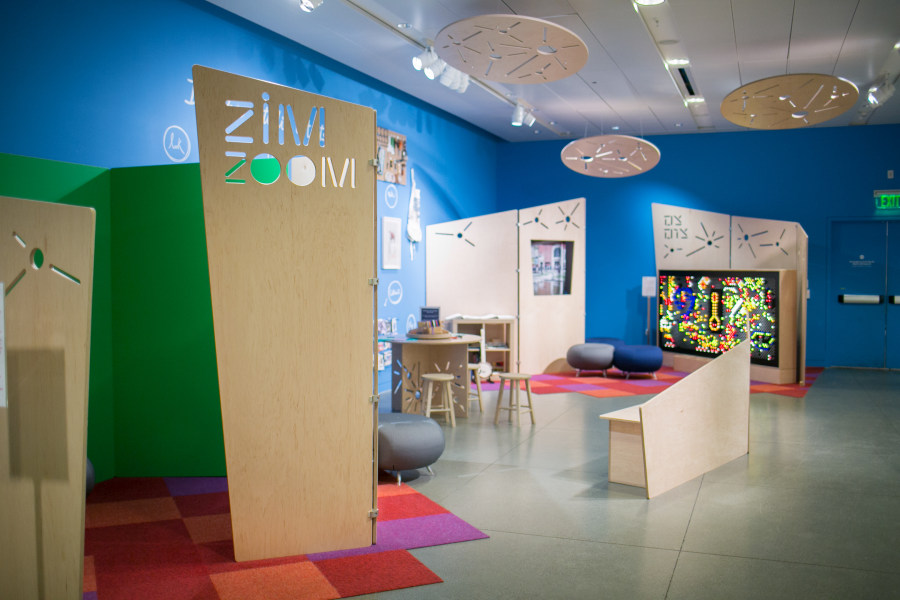
Ascha Drake, In the Studio, 2014. Photo by Gary Sexton Photography
The Sala Webb Education center at The CJM welcomes thousands of school age children each year, providing studio classrooms to expand the learning in the galleries.
In addition to this wonderful usage of the studio classrooms, families with children represent a significant segment of our visitors, and we knew that we needed an “evergreen” space for them—an engaging hands-on environment that invites adults and children to create and unwind together. With a long-term installation moving out of The CJM, a space at the end of the Sala Webb Education center opened for new possibilities.
The Zim Zoom Family Room was born out this confluence, and this fall we’re celebrating five years as an inventive oasis for adults and kids alike. Named for the mystically understood tzim tzum—or contraction, a moment of creation in Jewish tradition—the Zim Zoom Family Room has created space for visitors' creativity within a museum context.
Featuring a shadow puppet theater, a giant light wall, a maker table, and a screening booth with films on Jewish life, the Zim Zoom Family Room is further activated each year with commissioned interactive installations by local artists.
The first artist installation to activate Zim Zoom was a floor to ceiling installation entitled In the Studio by Ascha Drake in which the artist recreated her entire studio wall in the space. Drake added areas for visitors to make their own art using custom made texture plates, colored tapes, and her photographs. With Drake’s piece, we immediately saw an increase in the length of time visitors spent in the Zim Zoom Family Room—evidence that the changing artist installations anchored the space and made the room a conversation between visitor and artist.
These findings informed our decision to create a bigger impact with our light activity. With connections to both The CJM building’s former use as a PG&E power station and its role in Jewish life, light proved an important element to highlight. We replaced a light table with a giant wall of light, where visitors could build complex shapes and letters using over a thousand colored pegs.

Ascha Drake, In the Studio, 2014. Photo by Gary Sexton Photography
Through the years, the artist installations have offered an alternative take on what could be done in this kind of hands-on family environment, expanding the boundaries of what was expected.
In Drawing Machine II, Oakland-based artist Evan Holm gutted the insides of an old piano, adding inked paint brushes activated by the strike of a key. When played, instead of emitting sound, visitors created a drawing on a motorized paper scroll. Over time, this work represented a continuous collaborative artwork that moved across the entire length of the wall. Playing and watching the piano transfixed everyone who stopped to witness as it rolled out its particular calligraphy.
Evan Holm, Drawing Machine 2, 2016. The Contemporary Jewish Museum, San Francisco
Artist Marty McCutcheon’s Light Box Theater used video mapped projections of synagogues, waterfalls, and beehives (in honor of Rosh Hashanah) to explore the idea of sanctuary and Jewish space. The images were projected on lightweight movable boxes, allowing visitors to build new multi-dimensional scenes every seven minutes.
Marty McCutcheon, Light Box Theater, 2017. Interactive installation in the Zim Zoom Room at The Contemporary Jewish Museum of San Francisco. Camera by C.K. Itamura. Music by Experimentalkase
This year, we invited artist Mary Anne Kluth to transform the Zim Zoom Family Room into a wilderness of the imagination. Reminiscent of a theater set, this installation of trees, cascades, and far-off mountains is composed from Kluth’s photographs of theme park landscape sets from places like California Adventure and Tokyo Disney Sea.
When selecting a painting that would become the basis on this piece, Kluth was inspired in part by this quote by Abraham Joshua Heschel:
The seventh day is like a palace in time with a kingdom for all. It is not a date but an atmosphere. It is not a different state of consciousness but a different climate; it is as if the appearance of all things somehow changed.
—Abraham Joshua Heschel The Sabbath: Its Meaning for Modern Man (1951), p. 21.
Artist Mary Anne Kluth discusses her installation Master Study: Grand Teton National Park, 2019.
As The Zim Zoom Family Room changes and evolves each year, we continue to strive to make it a creative atmosphere—a place where everyone is welcome to wonder, unwind, and connect.
See what's happing in the Zim Zoom Family Room!

Zim Zoom Family Room. Photo by Gary Sexton Photography

Andrea Guskin strives to create positive, meaningful experiences for families of all ages, backgrounds, and abilities. Through art workshops, family events, interactive gallery experiences, and the Zim Zoom Family Room, Guskin provides opportunities for families to engage with the art, culture, history, and ideas presented at The CJM. Partnerships with local organizations and artists play a vital role in this work, enabling The CJM to reach a wide audience with relevant and impactful programs. Guskin's own art practice informs the open ended approach to all of the family workshops at The Museum, encouraging an atmosphere of creative experimentation.
Mary Anne Kluth, Master Study: Grand Teton National Park, 2019. Hand cut wood, acrylic, hardware, and pigment print on vinyl, 14 x 9 x 5 ft. Courtesy of the artist and Satelliteof.Love, San Francisco